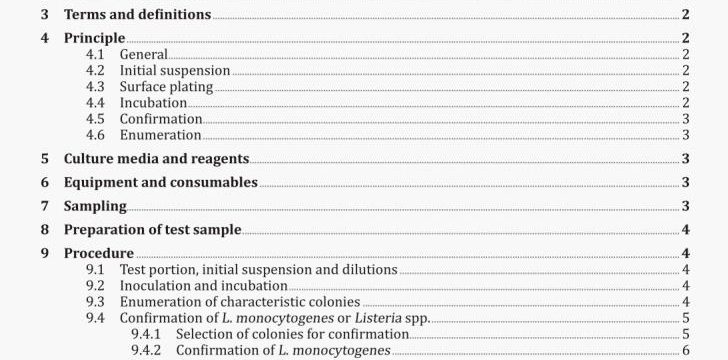Microbiology of the food chain
AS 5013.24.2-2020 pdf download.Food microbiology
Method 24.2: Microbiology of the food chain — Horizontal method for the detection and enumeration of Listeria monocytogenes and of Listeria spp. — Enumeration method.
8 Preparation of test sample
Prepare the test sample in accordance with the specific International Standard dealing with the product concerned Isee ISO 6887 (all parts) and ISO 18593]. If there is no specific International Standard, it is recommended that the parties concerned come to an agreement on this subject.
9 Procedure
9.1 Test portion, initial suspension and dilutions
Buffered peptone water, as well as other appropriate diluents referred to in ISO 6887 (all parts) and any specific International Standard appropriate to the product concerned, may be used as diluent for the initial suspension.
Half-Fraser broth (as specified in ISO 11290-1), supplemented with selective agents or not, may he used as a diluent for the initial suspension when both the detection method (as specified in ISO 11290-1) and this enumeration method are carried out on the same test sample. The selective agents should be added (If required) to the suspension preferentially after enumeration, prior to the detection method.
If supplemented half-Fraser is used, inoculate the plates as soon as possible, up to 45 mm.
9.2 Inoculation and incubation
9.2.1 Distribute, by means of a sterile pipette (6.8), 0,1 ml of the Initial suspension (or sample If liquid) and 0,1 ml of further decimal dilutions each inoculated onto the surface of a small dish (90 mm) of Agar Listeria according to Ottaviani and Agosti (see B.2).
When, for certain products, it is desirable to estimate low numbers of L. monocytogenes and/or Listeria spp., the limits of detection may be raised by a factor of 10 by examining I ml of the test sample if the initial product is liquid, or 1 ml of the initial suspension for the other products. Distribute the 1 ml of inoculum either on the surface of a large Petri dish (140 mm) or over the surface of three small dishes (90 mm), dried beforehand if necessary in the incubator (6.2). If only the initial suspension is used, also prepare duplicate plates using an additional three small Petri dishes or one large dish of medium (see ISO 7218).
Repeat the procedure using 0,1 ml of the initial suspension (or sample if liquid) and 0,1 ml of further decimal dilutions if necessary each inoculated onto the surface of a small dish (90 mm) of agar medium.
9.2.2 Carefully spread the inoculum as quickly as possible over the surface of the agar plate without touching the sides of the dish with the spreader (6.6). Use a fresh sterile spreader for each dilution. Leave the plates closed and upright for about 15 mm at ambient temperature for the inoculum to be absorbed into the agar.
9.3.2 Consider as L. monocytogenes the blue-green colonies surrounded by an opaque halo (typical colonies). Colonies of L. ivanovil are also blue-green and surrounded by an opaque halo.
NOTE 1 Some strains of L. monocytogenes exposed to stress conditions, particularly acid stress, may show a very weak halo (or even no halo),
NOTE 2 Sonic rare L. monocytogenes are characterized by a slow PIPLC (phosphatidyl inositol phospholipase C) activity. Such bacteria are detected when the total duration of incubation is more than, for example. 4 days. Some of these strains could be pathogenic.l’°l No L. monocytogenes strains have been described as PIPLC negative.
9.3.3 Consider as presumptive Listeria spp. the blue-green colonies with or without opaque halo. NOTE Some organisms other than Listeria spp. may produce blue colonies on this medium. See Annex C.
9.3.4 Count all the colonies presumed to be L. monocytogenes (9.3.2) on each Petri dish containing less than 150 L monocytogenes characteristic colonies, or less than 360 L. monocytogenes characteristic colonies if 140 mm Petri dishes are used.
9.3.5 Count all the colonies presumed to be Listeria spp. (9.3.3.) on each Petri dish containing less than
150 Listeria spp. characteristic colonies, or less than 360 Listeria spp. characteristic colonies if 140 mm
Petri dishes are used.
In case of mixed cultures of blue-green colonies with or without opaque halo, or In case of blue- green colonies with large and overlapping opaque halos, it is preferable to count the colonies on each Petri dish containing less than 100 Listeria spp. characteristic colonies, or less than 240 Listeria spp. characteristic colonies if 140 mm Petri dishes are used.
9.4 Confirmation of L. monocytogenes or Listeria spp.
9.4.1 Selection of colonies for confirmation
9.4.1.1 Consider each group of three 90 mm Petri dishes used for the initial suspension as one dish. If on one dish there are fewer than five presumptive colonies, take all of them for confirmation.
9.4.1.2 For confirmation of presumptive L. monocytogenes, take from each Petri dish, representing each dilution, five colonies in total, representative for each colony type (e.g. with large halo and small halo).
Streak the selected colonies onto the surface of pre-dried plates of a non-selective agar, for example blood agar, nutrient agar, tryptone soya yeast extract agar (TSYEA) (B.1) in a manner which will allow isolated colonies to develop.AS 5013.24.2-2020 pdf download.
Microbiology of the food chain
